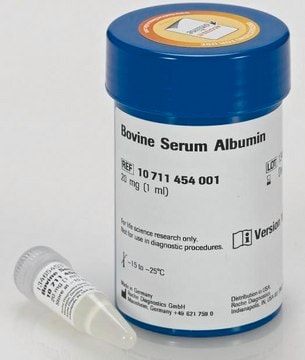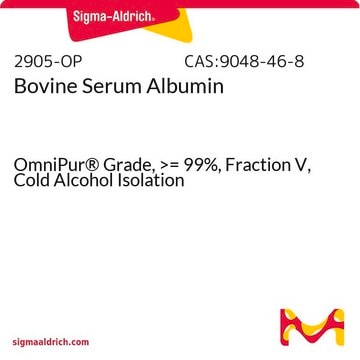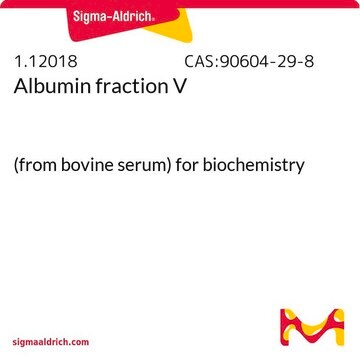10775835001
Roche
Bovine Serum Albumin
98.5% (electrophoresis), Fatty acids (total) ≤0.2 mg/g, Triglycerides (enzym.) free, Immunoglobulins not detectable, microbiological culture: suitable, USA origin
Synonym(s):
BSA, Bovine Serum Albumin Fraction V, fatty acid free, Bovine albumin, bovine serum
About This Item
Recommended Products
biological source
bovine
Quality Level
assay
98.5% (electrophoresis)
form
lyophilized
mol wt
Mr 68 kDa
packaging
pkg of 50 g
manufacturer/tradename
Roche
origin
USA origin
technique(s)
immunofluorescence: suitable
ligand binding assay: suitable
impurities
Immunoglobulins, none detected
Triglycerides, none detected
≤0.2 mg/g fatty acids
UniProt accession no.
shipped in
wet ice
storage temp.
2-8°C
Gene Information
bovine ... ALB(280717)
Looking for similar products? Visit Product Comparison Guide
General description
BSA is a single polypeptide chain consisting of about 583 amino acid residues and no carbohydrates. At pH 5-7, it contains 17 intra-chain disulfide bridges and one sulfhydryl group.
Application
- in lipid research to study lipid metabolism in biological systems
- to identify transport mechanisms in living organisms
- to study ligand binding
- to investigate ionic binding
- in the preparation of solutions during isolation of cardiomyocytes
- as a blocking solution to incubate embryos for immunofluorescence
- in dual polarisation interferometry (DPI) to study the interaction between membrane active peptides and artificial bilayers
Biochem/physiol Actions
Features and Benefits
- Free from fatty acids according to current quality control procedures (suitable for lipid research)
- High quality
- Low content of heavy metal ions
- Long-term stability
Quality
Contaminants: <0.2 mg fatty acids/g, triglycerides not detectable (enzymatic), immunoglobulins not detectable (Ouchterlony), ≤5% H2O,≤30 ppm heavy metals
Other Notes
Storage Class
11 - Combustible Solids
wgk_germany
WGK 1
flash_point_f
Not applicable
flash_point_c
Not applicable
Choose from one of the most recent versions:
Already Own This Product?
Find documentation for the products that you have recently purchased in the Document Library.
Customers Also Viewed
and Artificial Bilayers by Dual Polarisation Interferometry
Our team of scientists has experience in all areas of research including Life Science, Material Science, Chemical Synthesis, Chromatography, Analytical and many others.
Contact Technical Service








